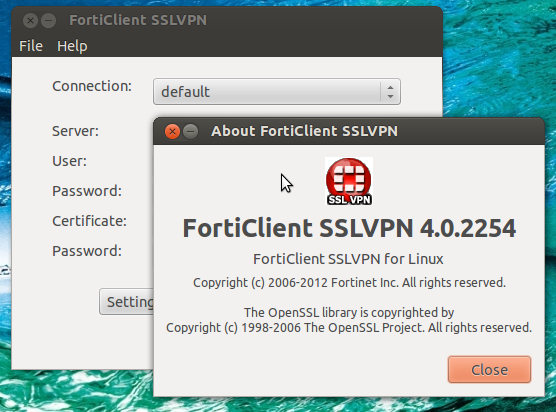

- #FORTIGATE VPN CLIENT FOR FREE#
- #FORTIGATE VPN CLIENT CODE#
- #FORTIGATE VPN CLIENT PASSWORD#
- #FORTIGATE VPN CLIENT WINDOWS#
#FORTIGATE VPN CLIENT FOR FREE#
The features that are available for free are only for FortiClient VPN clients, not other solutions.
#FORTIGATE VPN CLIENT CODE#
If for whatever reason this code does not appear, you can access this code via the command line. The user will need to use this code to configure FortiToken Mobile so that they can then use this device for MFA.

Since we have configured our system to use MS-CHAP-v2, you will always receive a failure message is you attempt to use this button. *NOTE: the ‘Test User Credentials’ button will not work, no matter how you configure your settings as this is only designed to function with the insecure PAP security protocol. You should get a green response saying that connectivity is successful. Once the configuration settings are in place you can select the ‘Test Connectivity’ button.
#FORTIGATE VPN CLIENT PASSWORD#

#FORTIGATE VPN CLIENT WINDOWS#
Give your RADIUS server a name (can match Windows server name for easy identifiability). For now, we’ll stick with the FortiGate and a typical AD authentication setup. They even have a dedicated appliance that is specifically designed for authentication offload called the FortiAuthenticator, but we’ll get into that in another article. It’s important to note that Fortinet allows for their FortiToken functionality to scale well above and beyond what we’ll be looking at today. Today, we’ll be using these included ‘FortiTokens’ to setup our VPN. Fortinet provides an included two licenses of FortiToken (Two-Factor Auth) per FortiGate as a way of allowing administrators to experience the power and simplicity of this feature. The example below is designed to show this configuration in the most basic sense, using only the features that come with a standard FortiGate appliance. I wanted to show a real-life example of how we could provide secure multifactor VPN without having to break the bank. The article below has been written to demonstrate the authentication features of the Fortinet security appliance suite, specifically their flagship product, the FortiGate firewall. Obviously, there are many choices available, but we found only one that had the scalability necessary to start off small and cost effective, and ultimately scale to hundreds if not thousands of users. As a part of our continued efforts to provide technical guidance for our clients, a request was made recently as to whether or not we could provide a highly secure, multifactor authentication methodology for remote VPN users.


 0 kommentar(er)
0 kommentar(er)
